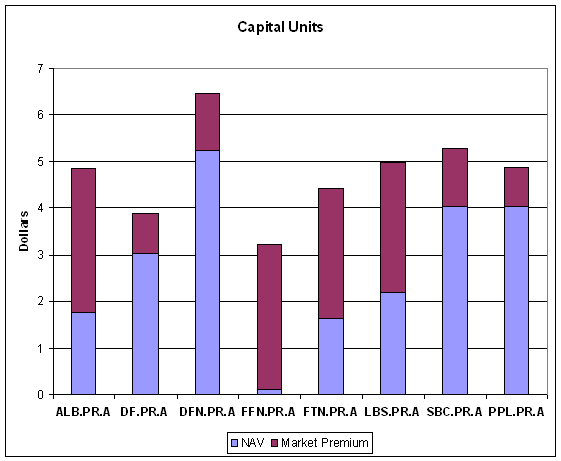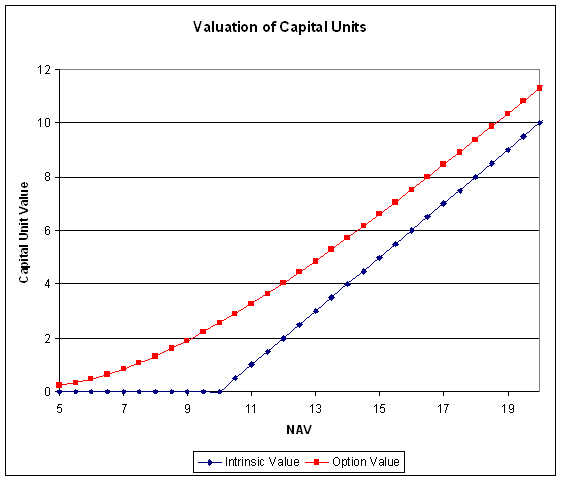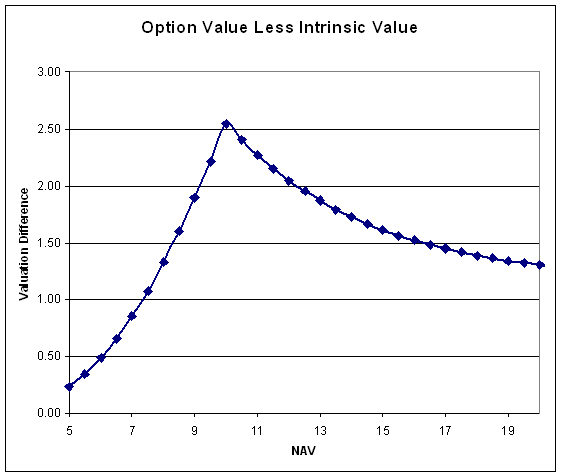I have received not just one, but two separate inquiries about the calculation of a final dividend lately, so I’ll publish this note to assist those who are too shy to eMail me…
For those unwilling to plough through the following (cough, cough), final dividend calculation may be summarized as:
- Dividends are paid for a specific period
- This period usually, but not always, is up to and including the payment date.
- Ex-date and record date have nothing to do with it – at least, not in any instances of which I am aware
- For an explanation of the dates, read my essay Dividends and ex-Dates
- To determine the periods over which dividend payments are earned, read the prospectus with respect to the first dividend … the prospectus will generally include some statement along the lines of: “The first dividend will be paid on XXXX, and will be for $YYY per share, assuming that the issue closes on ZZZZ”. The fraction of a year between XXXX and ZZZZ will generally, but not always be equal to the fraction of the annual dividend paid on ZZZZ.
So, the first inquiry was sent by Assiduous Reader KB:
I wonder if you could clear up a question I have about Fixed Reset shares.
I was reading this months PrefLetter and was a bit confused by a yield calculation, so I went to the prospectus of some Fixed-Reset shares I own.
Both bank fixed-resets (RY.PR.P and TD.PR.K) are worded a particular way that concerns me, yet two non-bank fixed-resets MFC.PR.D and BAM.PR.P) are worded differently.
The bank fixed-resets state that dividends are paid every quarter, but excludes the initial rate on the last dividend for the final reset/call date? (see the pertinent prospectus excerpt reprint below.)
The non-bank fixed-resets include the initial rate on the last dividend for the final reset/call date? (see the pertinent prospectus excerpt reprint below.)
Question: Are the banks indicating that the dividend on the reset/call date (if reset) will be at the new dividend rate, and (if called) will be at the old dividend rate, yet the non-banks pay the old dividend rate on the reset/call dates regardless if called or reset?
RY.PR.P
Our Non-Cumulative 5-Year Rate Reset First Preferred Shares, Series AP (the “Series AP Preferred Sharesâ€) will be entitled to fixed non-cumulative preferential cash dividends, payable quarterly on the 24th day of February, May, August and November in each year, as and when declared by our board of directors, for the initial period from and including the closing date of this offering to, but excluding, February 24, 2014 (the “Initial Fixed Rate Periodâ€) at a per annum rate of 6.25%, or $1.5625 per share per annum. The initial dividend, if declared, will be payable on May 24, 2009 and will be $0.55651 per share, based on an anticipated issue date of January 14, 2009 …………………….. Subject to the provisions of the Bank Act (Canada) (the “Bank Actâ€) and the consent of the Superintendent of Financial Institutions Canada (the “Superintendentâ€), on February 24, 2014 and on February 24 every fifth year thereafter, we may redeem the Series AP Preferred Shares in whole or in part by the payment of $25.00 in cash per share together with declared and unpaid dividends to the date fixed for redemption.MFC.PR.D
This offering (the “Offeringâ€) of Non-cumulative Rate Reset Class A Shares, Series 4 (the “Series 4 Preferred Sharesâ€) of Manulife Financial Corporation (“MFCâ€) under this prospectus supplement (the “Prospectus Supplementâ€) consists of 14,000,000 Series 4 Preferred Shares. The holders of Series 4 Preferred Shares will be entitled to receive fixed non-cumulative preferential cash dividends, as and when declared by the board of directors of MFC (the “Board of Directorsâ€), for the initial period commencing on the Closing Date (as defined herein) and ending on and including June 19, 2014 (the “Initial Fixed Rate Periodâ€), payable quarterly on the 19th day of March, June, September and December in each year (each three-month period ending on the 19th day of each such month, a “Quarterâ€), at an annual rate equal to $1.65 per share. The initial dividend, if declared, will be payable June 19, 2009 and will be $0.4837 per share, based on the anticipated closing date of March 4, 2009 (the “Closing Dateâ€) …………………….. The Series 4 Preferred Shares will not be redeemable by MFC prior to June 19, 2014. On June 19, 2014 and on June 19 every five years thereafter, but subject to the provisions of the Insurance Companies Act (Canada) (the “ICAâ€), including the requirement of obtaining the prior consent of the Superintendent of Financial Institutions (the “Superintendentâ€), and subject to certain other restrictions set out in “Details of the Offering — Certain Provisions of the Series 4 Preferred Shares as a Series — Restrictions on Dividends and Retirement of Series 4 Preferred Sharesâ€, MFC may, at its option, on at least 30 days and not more than 60 days prior written notice, redeem for cash all or from time to time any part of the outstanding Series 4 Preferred Shares for $25.00 per Series 4 Preferred Share, together in each case, with an amount equal to the sum (the “Accrued Amountâ€) of (i) all declared and unpaid dividends in respect of completed Quarters preceding the date fixed for redemption; and (ii) an amount equal to the cash dividend in respect of the Quarter in which the redemption occurs, whether declared or not, pro rated to such date.Thanks,
I answered with the following:
There is no need to worry.
If you examine the prospectus for TD.PR.S (http://www.td.com/document/PDF/investor/td-investor-s[1].pdf) you will see that it is worded similarly to the other banks: “The holders of the Series S Shares will be entitled to receive fixed quarterly non-cumulative preferential cash dividends, as and when declared by the board of directors of the Bank (the “Board of Directors”), for the initial period from and including the closing date of this offering to but excluding July 31, 2013 (the “Initial Fixed Rate Period”), payable on the last day of January, April, July and October in each year (each three-month period ending on the last day of each such month, a “Quarter”), at a per annum rate of 5.00% per share, or $0.3125 per share per Quarter”
The dividends for the final period were at the old rate:http://td.mediaroom.com/2013-05-23-TD-Bank-Group-Declares-Dividends
I believe that this is simply due to questions about how to count the days and refer to this count, given that interest is actually earned overnight (between the close on day X and the opening on day X+1) rather than during the day.
Every lawyer will have his own idea about whether the interest earning period is day X or day X+1 and draft the prospectus accordingly. And once the first prospectus is drawn up for a given firm, it is used as a template for the next one.
The next question came from Assiduous Reader GK:
Specifically, on BNA.PR.D, I know the call is July 9, 2014, and the last dividend record date is May 22 (or thereabouts).
I am interested in this series for a short term investment.
My question is, is there any accrued interest in the period between May 22 and the call date, July 9?
And my response:
This one is a little tricky and requires us to have a look at the prospectus for the issue, available on SEDAR.
First: “All Series 4 Preferred Shares outstanding on July 9, 2014 (the ‘‘Series 4 Redemption Date’’) will be redeemed for a cash amount equal to the lesser of (i) $25.00 plus any accrued and unpaid dividends, and (ii) the Net Asset Value per Unit.”
So on July 9 we will indeed be paid accrued dividends, if any. Are there any? With respect to the first dividend, the prospectus states: “Based upon the anticipated closing date of July 9, 2009, the initial dividend (which covers the period from closing to August 31, 2009) is expected to be $0.26318 per Series 4 Preferred Share and is expected to be paid on or before September 7, 2009 to holders of record on August 21, 2009.”
So checking: July 9 to August 31 is 22 + 31 = 53 days, and the expected dividend is: quarterly divided * 4 * fraction of year = paid dividend, or
$0.453125 * 4 * (53/365) = 0.263185
Which agrees with their calculation (except they rounded down, the bastards!)
So dividends are paid for quarterly periods ending at month-end February, May, August and November.
Therefore, on redemption July 9, dividends will be owing for the period May 31 – July 9 = 39 days = (39/365) of a year, so:
$0.453125 * 4 * 39/365 = 0.193664.
So it would appear that accrued and unpaid dividends of 0.193664 per share will be paid on redemption July 9, 2014. I urge you to double check this calculation and see if you can get confirmation from the company itself – see contact information at http://www.bamsplit.com/


